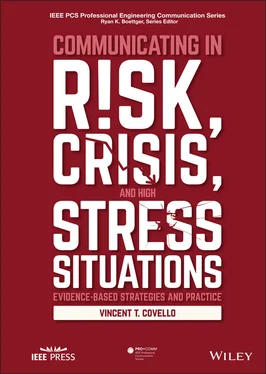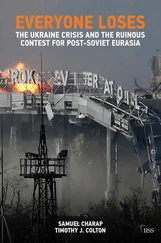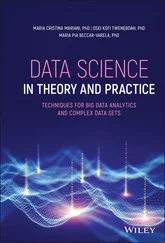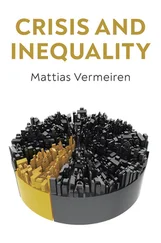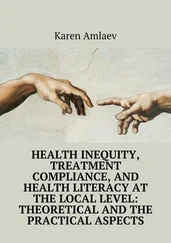Leiss’s Phase 3 corresponds to Fischhoff’s Stages 7 and 8. Leiss points out that each phase emerged in response to the earlier one. The earlier ones do not become irrelevant; instead, they are incorporated into the later phases. Each has value.
4.2.4 Covello and Sandman’s Four Stages of Risk Communication
In their review of the history of risk communication, Covello and Sandman (2001) identified phases in the history of risk communication relating to health, safety, and environmental issues. 7 Covello and Sandman noted that for more than 60 years nations and organizations witnessed a tremendous take‐back of power and control by people over risk management policies. In the mid‐twentieth century, people were largely content to leave the management and control of risks in the hands of established authorities. However, by the end of the twentieth century and beginning of the twenty‐first century, people around the world had legislatively asserted their claim to be involved in setting and implementing policies regarding risk management and decision‐making. People became visibly upset and even outraged when they felt excluded from the risk management decision‐making process.
Covello and Sandman argued it was in this crucible that the basic tenets of risk and crisis communication were born. The tenets were created, in part, to guide the new partnerships and dialogs with those affected by risks and crises. They provided science‐based guidance for confronting the dilemma that perception equals reality, or becomes reality, and that which is perceived as real is real in its consequences.
Recognizing this dilemma, researchers examined whether there were science‐based and ethical ways to calm people and provide reassurance, particularly when data showed a risk was not large but people perceive it to be large and are upset, angry, or outraged. Researchers also examined whether there were science‐based and ethical ways to overcome apathy when data shows a risk is large and yet people perceive it to be insignificant and not deserving their attention.
This is the general context for the interest in risk communication that began in the 1960s and continues to this day.
In part, risk communication principles and tools were identified and developed to overcome communication obstacles. These obstacles included inconsistent, overly complex, confusing, or incomplete messages about risks; the lack of trust in information sources; selective reporting by the media; and psychological and social biases that affect how risk‐related information is processed.
Covello and Sandman described four evolutionary stages in the development of risk communication in terms of the changes in guiding philosophy and approach. The philosophical changes are core to understanding current practice and research.
4.2.4.1 Stage 1: Ignore the Public
The first stage was simply to ignore the public. This stage was prevalent in the United States until the late 1960s. The approach was built on the assumption that many people were apathetic about most health, safety, and environmental risk issues. As a result, they were willing to delegate decision‐making to technical, engineering, and scientific professionals. Under these conditions, the best communication strategy was to ignore the public, or, when necessary, mislead them. Protect the public’s health, safety, and environment, but do not let them take part in the decision‐making.
For a long time, the public was content to be ignored regarding risk issues. But this approach stopped working, particularly in the late 1960s and early 1970s. Movements focused on taking back power and participating more directly in risk‐related decision‐making. Increasingly, when risk management authorities ignored the public, controversies became larger. This was the experience for many industries, including the nuclear power, pharmaceutical, and chemical industries. For example, in the early 1960s, thalidomide, a widely used drug for the treatment of nausea in pregnant women, was taken off the market due to massive pressure from the press and public. Experts estimated that thalidomide led to deaths and serious birth defects in thousands of children.
4.2.4.2 Stage 2: Explaining Risk Data Better
Since ignoring the public did not work, risk managers and communicators advanced to the second stage: learning how to explain risk data better. This is where many organizations are still today. Researchers developed new techniques for explaining risk assessment concepts, such as parts per billion, how assessments are conducted, and how management decisions are made. Researchers developed improved methods for interactions with the media, for reducing or eliminating the use of jargon, and for developing and using visual aids.
Most important, risk managers and communicators discovered listening and motivation were keys to learning. While risk communication materials can be developed for an average person to comprehend, people will process the information only if they are motivated and feel their concerns have been heard. When people are sufficiently motivated and feel heard, they can understand even complex technical material. For example, average people can process the probabilities associated with gambling and the complexities of mortgage rates.
For some risk problems, when the risk is large and the controversy is minimal, doing a better job with explaining risk information is the most important piece of the puzzle. For example, when people believe they have control over a particular risk, when the risk is perceived to be voluntary, and when risk management institutions are trusted, explaining data better often leads to improved decision‐making. For other risk problems, such as when experts claim the risk is not significant or large, but when people are extremely concerned or outraged, explaining risk information is seldom effective in calming people or reducing outrage. Researchers and risk managers recognized solutions had to be found elsewhere.
Several events influenced developments during Stage 2. One was the passage of multiple laws requiring public participation, consultation, and the right‐to‐know. A second were events that resulted in public outrage. One such event was the nuclear power plant accident at Three Mile Island in Pennsylvania. The accident was the most significant accident in US commercial nuclear power plant history. It raised awareness of the dangers associated with industrial facilities and concerns about caring, competence, honesty, and transparency by industry. Two other significant events in Stage 2 were the ban by the US Environmental Protection Agency (EPA) on the use of the pesticide dichloro‐diphenyl‐trichloroethane (DDT) 8 and the hazardous waste crisis at Love Canal, New York. 9 President Jimmy Carter’s declaration of a State of Emergency at Love Canal was made following an increase in skin rashes, miscarriages, and birth defects among residents.
Both the DDT and Love Canal events raised public awareness of, and concerns about, the risks associated with agricultural chemicals and the unregulated dumping of hazardous waste. These and related events also heightened awareness of the difficulties and challenges of risk communication and presenting risk data to emotionally charged audiences.
During Stage 2, scientists developed many techniques for explaining and putting risk data in perspective. One of the most popular of these techniques was to present risk comparisons. 10 Empirical evidence and theory suggested that risk comparisons could improve public understanding of risks and encourage the adoption of protective behaviors. Researchers hypothesized that risk comparisons could be especially useful in helping people make informed decisions about low‐probability, high‐consequence events, such as major flood or earthquake. 11
Читать дальше
